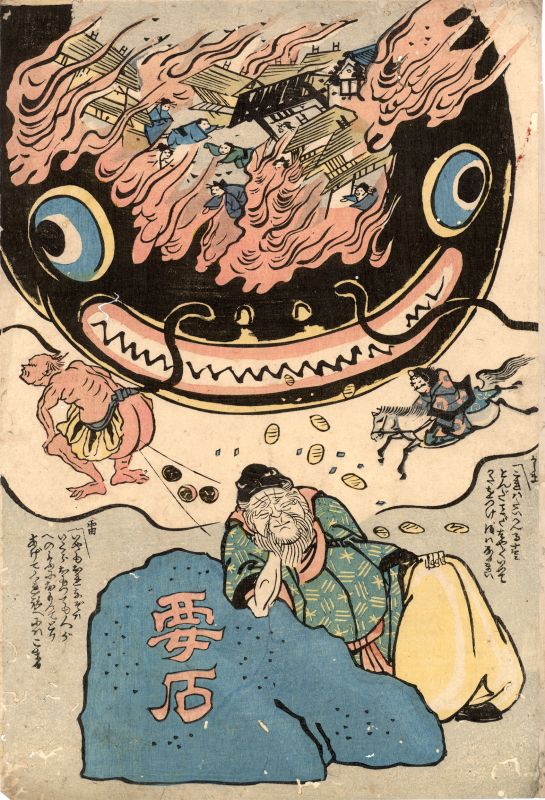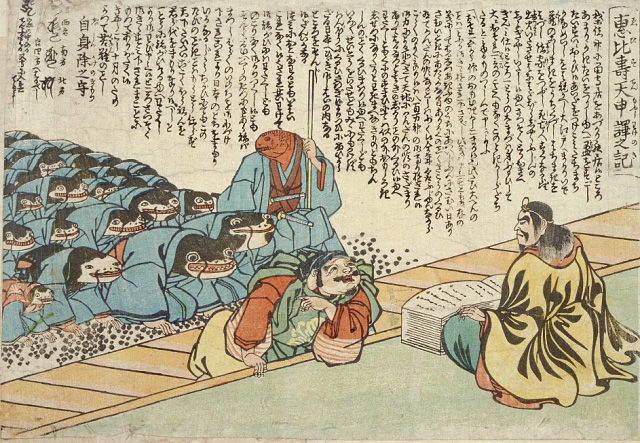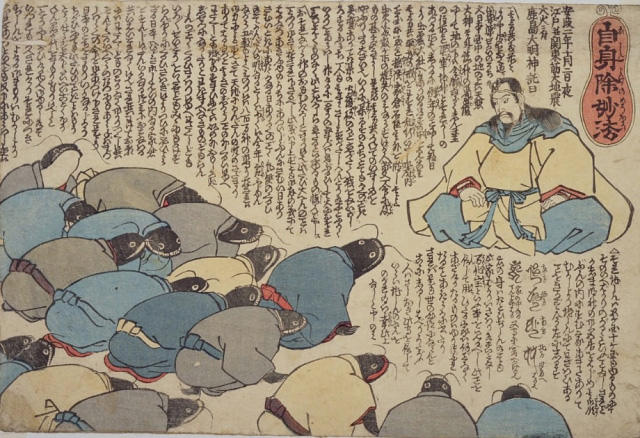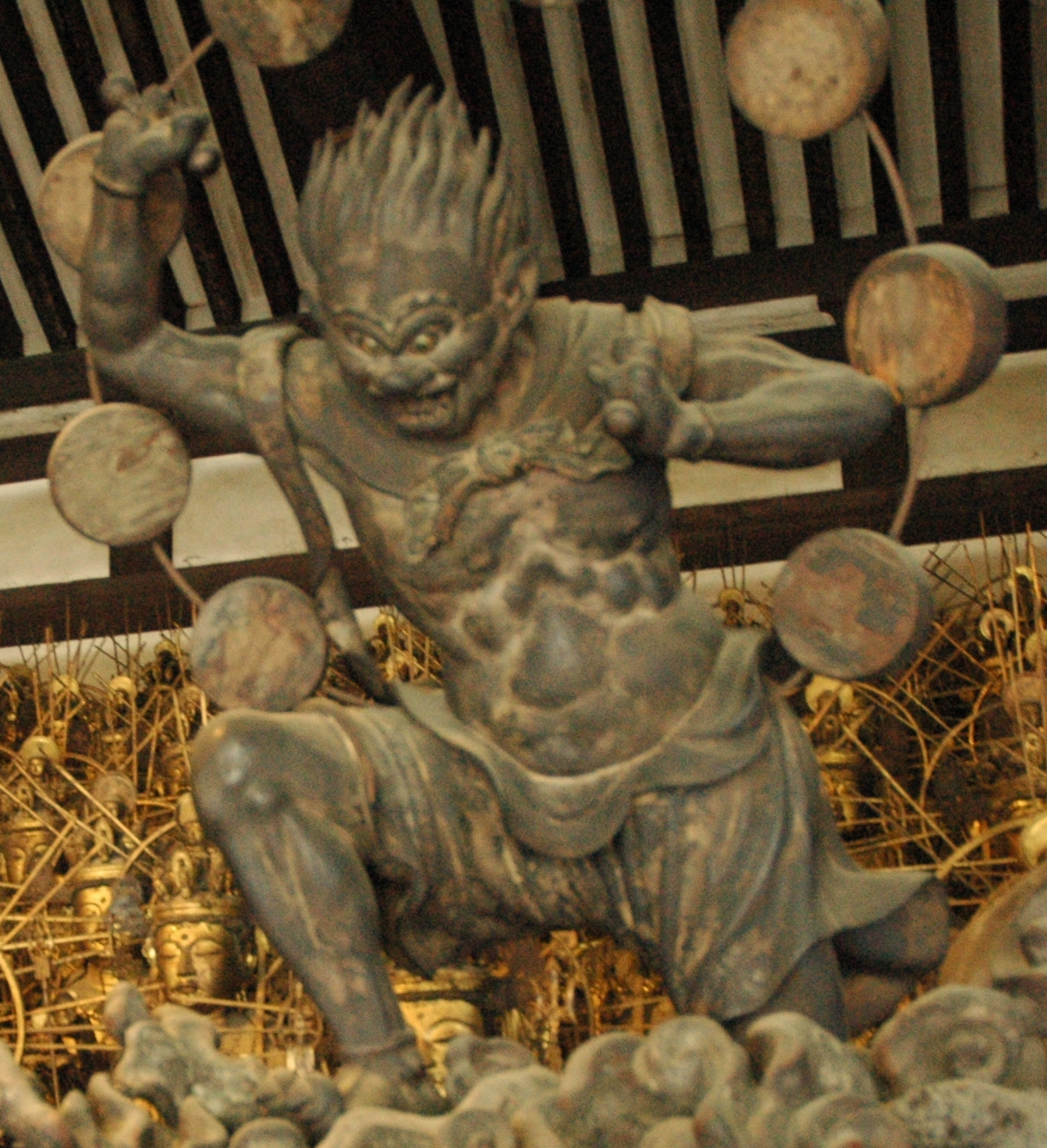So I recently posted this about the discovery of medieval dick trees by a friend of mine. We decided to do a bit more research, in the interest of sharing the spirit of medieval penises with all, which has nothing to do with the fact that I'm a history-obsessed teenage girl. *ahem*
Apparently, it has everything to do with witchcraft and propaganda.
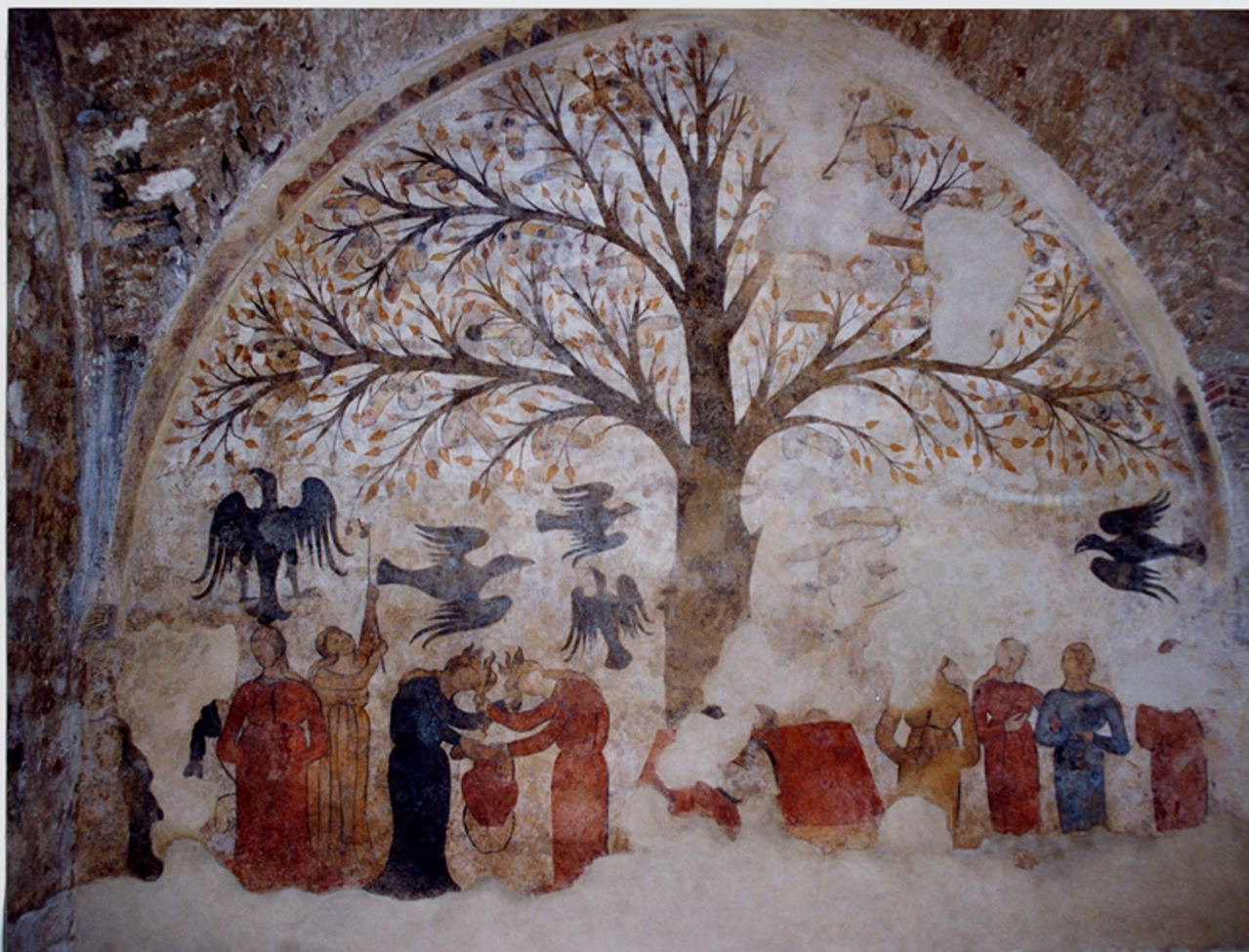
On the subject of this image, which is actually a mural at a fountain and was included in the aforementioned post, George Ferzoco, director of the Centre for Tuscan Studies at the University of Leicester, has written an entire book. He claims that the mural was really a giant slur against a political group called the Ghilbellines by a political group called the Guelphs. Roughly speaking, the Ghibellines were a rural people who supported the Holy Roman Empire, while the Guelphs were wealthier and supported the Pope. They liked to argue and go to war against each other a lot and, according to Ferzoco, the Guelphs had just (however temporarily) kicked the Ghibellines out of Massa Marittima, the town in which this phallic mural was created.The black eagle was the symbol of the Guelphs (for reasons which escape me, as 'Guelph' is simply the Italian version of the Bavarian 'Welf' family, who were symbolised by a lion) and if you put it all together, Ferzoco claims the image says this: “if the Ghibellines are allowed power they will bring with them heresy, sexual perversion, civic strife and witchcraft.”
That's some pretty heavy mudslinging and to be perfectly honest, I'm not sure I buy it. Medievalists had little qualms about depicting things as they were; this is why we have a tree full of dicks and images of people with various weapons sticking out of them.
If the Guelphs truly wanted to show 'civic strife' wouldn't there be people murdering each other or robbing each other? Instead of a rather contented scene, with the exception of two women who appear to be cat-fighting?
If they wanted to show sexual perversion, wouldn't they have something barbaric taking place, rather than what appears to be one of the disembodied penises gently poking the back of a woman's dress? After all, if pins depicting characterised genitalia wearing hats, crowns, wings and anything else you can think of were common in the Middle Ages (if this sounds like a must-have for your wardrobe, see this site. They're actually rather cheap) and blatantly detached phalli were accepted enough to be depicted on a large mural, I hardly think that 'sexual perversion' would be limited to this.
Heresy, I can perhaps see, as I'm not certain on the godliness of cock-trees and their possible usages. But was this really the greatest threat the Guelphs could think up? "The Ghibellines will infest your towns with cock-trees! No grove, no orchard, no bower will be safe! The streets will be littered with dropped dicks and your old women will be hit upon the head as they recline in the shade!"
And the witch craft? Well according the the Malleus Maleficarum, a famous fifteenth century book dedicated to finding and eliminating all witches, that is precisely how the dicks got into the tree in the first place.
And what, then, is to be thought of those witches who in this way sometimes collect male organs in great numbers, as many as twenty or thirty members together, and put them in a bird’s nest, or shut them up in a box, where they move themselves like living members, and eat oats and corn, as has been seen by many and is a matter of common report?
…
For a certain man tells that, when he had lost his member, he approached a known witch to ask her to restore it to him. She told the afflicted man to climb a certain tree, and that he might take which he liked out of the nest in which there were several members. And when he tried to take a big one, the witch said: You must not take that one; adding, because it belongs to a parish priest.
Setting aside the obvious implications about parish priests and large members and the disturbing mental images of dicks eating corn (I think I saw that horror movie...) we now have another threat: "The Ghibellines will steal your dicks and put them in boxes and in trees!" I think that alone might have frightened men enough to keep them away, regardless of their political and religious views.
But Carl S. Pyrdum III of Got Medieval isn't so sure it has anything to do with witches. He states:
On the charge of witchcraft, I am less convinced. Beyond the problematic several centuries separating the Massa Marittima mural and the Malleus, there is little in the mural other than their proximity to the magic johnsons, that suggests that these women are witches.
I know I’m going to take some heat from the medieval witchcraft lobby here, but not every medieval woman found taking an interest in a suddenly mobile phallus should be considered a witch. The Bibliotheque Nationale, for instance, has a manuscript of the Romance of the Rose with a marginal illustration of a woman trying to fish a penis out of a penis tree, much like the woman in the Massa Marittima mural, and in the Romance of the Rose it’s usually just thought to be a joke about how lascivious women are. Similarly, there is the German medieval story, Nonnenturnier, in which a man quarrels with his penis so much that it decides to leave him, eventually ending up at a convent where a group of nuns hold a tournament to determine who will get to have it.
So what does this mural really mean? I'm no Medieval scholar and I welcome corrections, but it seems to me there are two different things at play here.
First is the obvious: the Medieval period was all about interesting analogies and ways of referring to things. Chaucer's use of 'something green may I get' was so effective that we still have children singing 'Greensleeves' without being aware they're mourning the departure of a sexual strumpet. Penises growing on trees is in no way a far-fetched allusion to fertility and sexuality. So more than likely this was simply an interesting way of promoting the fertile waters of the particular spring (and perhaps those who met there for liaisons).
But what about the eagles? Well, if you take a look at them, aren't they placed rather oddly? In contrast to the smooth flow of the rest of the piece and the generous spacing of the individuals, we have eagles crammed wherever they'll fit and flying in odd directions. Unless they have somehow become intoxicated by the phalli in the trees, they don't appear at all to fit with the style of the people below them.
I think what we have here is a case of medieval graffiti. I can't be sure, as I have no way to examine the original mural, but perhaps the eagles were added later by someone in support of the Ghibellines. Or perhaps what Ferzoco says is largely true and the Guelphs added the eagles in an attempt to villainise penis trees?
We may never know.
Apparently, it has everything to do with witchcraft and propaganda.

On the subject of this image, which is actually a mural at a fountain and was included in the aforementioned post, George Ferzoco, director of the Centre for Tuscan Studies at the University of Leicester, has written an entire book. He claims that the mural was really a giant slur against a political group called the Ghilbellines by a political group called the Guelphs. Roughly speaking, the Ghibellines were a rural people who supported the Holy Roman Empire, while the Guelphs were wealthier and supported the Pope. They liked to argue and go to war against each other a lot and, according to Ferzoco, the Guelphs had just (however temporarily) kicked the Ghibellines out of Massa Marittima, the town in which this phallic mural was created.The black eagle was the symbol of the Guelphs (for reasons which escape me, as 'Guelph' is simply the Italian version of the Bavarian 'Welf' family, who were symbolised by a lion) and if you put it all together, Ferzoco claims the image says this: “if the Ghibellines are allowed power they will bring with them heresy, sexual perversion, civic strife and witchcraft.”
That's some pretty heavy mudslinging and to be perfectly honest, I'm not sure I buy it. Medievalists had little qualms about depicting things as they were; this is why we have a tree full of dicks and images of people with various weapons sticking out of them.
 |
| wound surgery, 1517. This poor fellow must have the worst luck in the world |
If the Guelphs truly wanted to show 'civic strife' wouldn't there be people murdering each other or robbing each other? Instead of a rather contented scene, with the exception of two women who appear to be cat-fighting?
If they wanted to show sexual perversion, wouldn't they have something barbaric taking place, rather than what appears to be one of the disembodied penises gently poking the back of a woman's dress? After all, if pins depicting characterised genitalia wearing hats, crowns, wings and anything else you can think of were common in the Middle Ages (if this sounds like a must-have for your wardrobe, see this site. They're actually rather cheap) and blatantly detached phalli were accepted enough to be depicted on a large mural, I hardly think that 'sexual perversion' would be limited to this.
Heresy, I can perhaps see, as I'm not certain on the godliness of cock-trees and their possible usages. But was this really the greatest threat the Guelphs could think up? "The Ghibellines will infest your towns with cock-trees! No grove, no orchard, no bower will be safe! The streets will be littered with dropped dicks and your old women will be hit upon the head as they recline in the shade!"
And the witch craft? Well according the the Malleus Maleficarum, a famous fifteenth century book dedicated to finding and eliminating all witches, that is precisely how the dicks got into the tree in the first place.
And what, then, is to be thought of those witches who in this way sometimes collect male organs in great numbers, as many as twenty or thirty members together, and put them in a bird’s nest, or shut them up in a box, where they move themselves like living members, and eat oats and corn, as has been seen by many and is a matter of common report?
…
For a certain man tells that, when he had lost his member, he approached a known witch to ask her to restore it to him. She told the afflicted man to climb a certain tree, and that he might take which he liked out of the nest in which there were several members. And when he tried to take a big one, the witch said: You must not take that one; adding, because it belongs to a parish priest.
Setting aside the obvious implications about parish priests and large members and the disturbing mental images of dicks eating corn (I think I saw that horror movie...) we now have another threat: "The Ghibellines will steal your dicks and put them in boxes and in trees!" I think that alone might have frightened men enough to keep them away, regardless of their political and religious views.
But Carl S. Pyrdum III of Got Medieval isn't so sure it has anything to do with witches. He states:
On the charge of witchcraft, I am less convinced. Beyond the problematic several centuries separating the Massa Marittima mural and the Malleus, there is little in the mural other than their proximity to the magic johnsons, that suggests that these women are witches.
I know I’m going to take some heat from the medieval witchcraft lobby here, but not every medieval woman found taking an interest in a suddenly mobile phallus should be considered a witch. The Bibliotheque Nationale, for instance, has a manuscript of the Romance of the Rose with a marginal illustration of a woman trying to fish a penis out of a penis tree, much like the woman in the Massa Marittima mural, and in the Romance of the Rose it’s usually just thought to be a joke about how lascivious women are. Similarly, there is the German medieval story, Nonnenturnier, in which a man quarrels with his penis so much that it decides to leave him, eventually ending up at a convent where a group of nuns hold a tournament to determine who will get to have it.
So what does this mural really mean? I'm no Medieval scholar and I welcome corrections, but it seems to me there are two different things at play here.
First is the obvious: the Medieval period was all about interesting analogies and ways of referring to things. Chaucer's use of 'something green may I get' was so effective that we still have children singing 'Greensleeves' without being aware they're mourning the departure of a sexual strumpet. Penises growing on trees is in no way a far-fetched allusion to fertility and sexuality. So more than likely this was simply an interesting way of promoting the fertile waters of the particular spring (and perhaps those who met there for liaisons).
But what about the eagles? Well, if you take a look at them, aren't they placed rather oddly? In contrast to the smooth flow of the rest of the piece and the generous spacing of the individuals, we have eagles crammed wherever they'll fit and flying in odd directions. Unless they have somehow become intoxicated by the phalli in the trees, they don't appear at all to fit with the style of the people below them.
I think what we have here is a case of medieval graffiti. I can't be sure, as I have no way to examine the original mural, but perhaps the eagles were added later by someone in support of the Ghibellines. Or perhaps what Ferzoco says is largely true and the Guelphs added the eagles in an attempt to villainise penis trees?
We may never know.







 When the Great Ansei Edo Earthquake struck what is now Tokyo, Japan on November 11th, 1855 there was only one thing on the minds of the survivors: Death to the catfish!
When the Great Ansei Edo Earthquake struck what is now Tokyo, Japan on November 11th, 1855 there was only one thing on the minds of the survivors: Death to the catfish!


